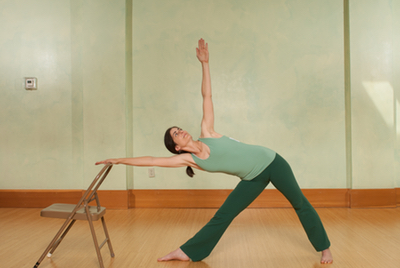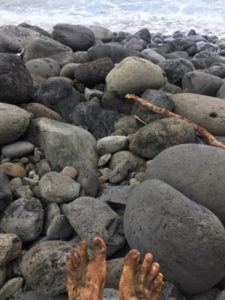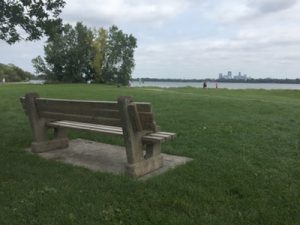
When I first started practicing yoga, Triangle (Trikonasana) was an iconic pose. Those who could get their hand all the way to the floor were considered to be advanced practitioners. Having a bit of hypermobility, I was able to accomplish this fairly quickly and thought I was doing good for my body.
Then I began to learn more about alignment and realized that lengthening the spine is a fundamental aspect and benefit of modern postural yoga. Yoga instructor Matthew Sanford puts it succinctly, “it’s all about the spine – stupid.” With this insight, I adjusted my practice to make the length of my spine a central focus of my practice. On days where I felt tighter, I reluctantly used a block.
Yet sometimes in class, as I looked around the room and saw bendy people placing their palms all the way to the floor, I still felt the pressure of achievement. Occasionally, I caved into this inner pressure and also reached toward the floor even though it compromised my spinal position. Fortunately, this ended on the day that I heard Ramanand Patel, a senior teacher in the Iyengar lineage firmly proclaim, “I’ve been to the floor, I’ve been below the floor and believe me, enlightenment is not there!” From that day forward I consistently practiced triangle pose with a block.
While I was studying and teaching yoga, I was also regularly playing soccer. I have a distinct memory of experiencing a disconcerting sensation on a cool evening at Martin Luther King Park in Berkeley. We were enjoying a playful scrimmage after a long series of intensive drills during our regular Tuesday evening practice. I kicked the ball to make a simple pass, something I had done thousands of times before, but this time was different. I felt a momentary gripping pain in my inner thigh. With my knowledge at the time, I thought I had tightened something and just needed to stretch. This moment began a 10 year journey as the pain became increasingly worse.
I continued practicing, teaching and studying yoga. My thigh still bothered me but I was able to compensate. A few years later, I went to study at the Iyengar Institute in Pune, India. This is the home base of the international Iyengar community and it is considered a prestigious privilege to be able to study there. In the formal classes I learned a great deal about asana and pranayama. While there, I also learned about what was becoming an open secret among the senior teachers: Many of them had hip problems. Even so, they kept pushing themselves into more extreme hip positions.
In my own body I knew something wasn’t right. I began to reevaluate the quest for flexibility and the need to do certain poses. I began to study with Donald Moyer, a senior teacher in Berkeley who wisely taught, “align yourself to your body, not the room.” Mary Paffard, one of my foundational teachers, began to talk about the dangers of “tricky Trikonasana.” I listened—and not because of the fabulous alliteration. She was observing that the way many people where practicing the pose could be leading to injury. She warned us about how following rigid instructions and pushing oneself into the pose could cause harm. She debunked the then common instruction to line up the front heel with the back arch and encouraged her students to keep the pelvis free instead of keeping the hip points in the same plane. Based on their suggestions, I made more modifications to my poses.
And yet the pain in my right thigh lingered. Cobbler’s Pose (Baddha Konasana), which I had easily done for years, was now painful. After consulting with many people, I determined that the pain I was experiencing was because of tightness in my psoas as a result of my scoliosis. Naturally, I thought the obvious things was to stretch my psoas but this only made matters worse.
I continued my quest to discover the culprit. Doctors, chiropractors and manual therapists acknowledged that I had a tight right psoas. I realized that the force of kicking a ball was at least one culprit. In order to heal, I decided I had to give up soccer. This was a great loss as I had been playing almost continuously since I was 12 years old. The sadness was not only for missing out on the joy of the game, but also for the social aspects of being an active member of Las Brujas, a team that I had co-founded 15 years earlier. I did my best to accept the loss. I continued to practice yoga but was much more conservative in my approach. Even with modifications, I realized Triangle was too tricky for me, so I stopped practicing it and teaching it.
I saw a number of allopathic doctors who, having a base cliental that rarely exercised and were eating the standard American diet, saw me as healthy and did not take my concerns seriously. As I was able-bodied it was difficult for them to empathize with how much this was affecting my life. Finally, my doctor approved an MRI. The first orthopedist who saw the results diagnosed me with Femoral Acetabular Impingement (FAI) and a torn labrum. He recommended surgery right away. I was frustrated and scared—the cost and recovery time were beyond my scope of imagination. I decided to get a second opinion. The second doctor was more conservative and said that at my age of 46, he didn’t think surgery would make any difference. He explained that while my hips didn’t have any signs of arthritis, I had some congenital dysplasia, a condition where the acetabulum (hip socket)does not fully cover the head of the femur (thigh bone.) Over time, this can lead to damage of the soft tissues, movement dysfunction and pain. He concluded that the pain I was experiencing was a natural effect of this “deformity.” He empathized with me, especially about giving up soccer (he was an avid athlete) but said that there was nothing really that I could do. I went to Fenton’s—the best ice cream parlor in the world—and as I shared a Black and Tan Sundae with a dear friend, I decided to try my best to walk the path of acceptance.
 For me, acceptance didn’t mean giving up my quest to heal my hip. It meant being present with the reality of the current situation while simultaneously trying to make it better. I became even more careful about which classes I attended and had no compunction about modifying poses. I studied the anatomy of the hip joint in great detail and started teaching myself to move in new ways. I took my time. I became a student of the Z-health, a neurologically based approach to movement and learned the importance of having clear proprioceptive maps. Every day I practiced very small and slow movements with my hips to safely explore my entire range of movement.
For me, acceptance didn’t mean giving up my quest to heal my hip. It meant being present with the reality of the current situation while simultaneously trying to make it better. I became even more careful about which classes I attended and had no compunction about modifying poses. I studied the anatomy of the hip joint in great detail and started teaching myself to move in new ways. I took my time. I became a student of the Z-health, a neurologically based approach to movement and learned the importance of having clear proprioceptive maps. Every day I practiced very small and slow movements with my hips to safely explore my entire range of movement.
I paid more attention to how other people practiced Triangle pose. I noticed an interesting phenomenon: in the quest to hinge more deeply in the front leg to support a long spine, many people were jamming into their back hip. To get a sense of this, imagine Olivia Newton-John at the end of Grease, putting out a lit cigarette with the tip of her high-heeled shoe while wearing skin-tight leather pants. She looks so cool! However, just as she is about to put out the cigarette with her right foot, she is leaning into her left hip and putting tremendous pressure on the bones of the hip joint as well as the soft tissue. You can see it at 1:04. Her movement bypasses the use of the gluteus medius, the all-important side buttocks muscle.
I began to see this habit many yoga practitioners, myself included. Tree pose (Vrksasana) was a big culprit. While focusing on balance, I leaned into the bones of the standing leg instead of using muscular strength. I realized that I must have been doing this for many years. The obvious course of action was to entirely retrain how I moved my hips.
I had been to many yoga classes where we were firmly instructed to release the buttocks muscles but now I realized that gluteal amnesia, which is a fancy way to say that the buttock muscles are weak, sleepy and atrophied, was part of the problem. I began to study the biomechanics of movement with Katy Bowman of Nutritious Movement™. Already having more than the average level of flexibility, I let go of my interest in going “deeper” into poses and focused on creating strength in different ranges of movement. Two of the movements that helped me the most were standing hip circles and hip lists (a term coined by Katy Bowman where one hip actively lowers down to lift the opposite leg up), both of which strengthen the gluteus medius in different ranges of movement. See here for short video of the hip lists and here for a video of the hip circles.
I also worked on changing my gait so that instead of throwing my leg forward, I pushed off of my rear foot and then engaged the gluteus medius of the opposite leg to give clearance for the back leg to come forward.
It took a few years. I had had to slow down quite a bit but I began to feel better—much better.
I returned to some of my previous activities that I had loved and sorely missed. In the mean time, I had also discovered Middle Eastern dance. I feel in love with the movements and the communal aspect of dancing together and decided to pursue that instead of soccer. As my pain dissipated and I got stronger, I felt it was time to revisit my old friend Trikonasana with new eyes. I started by practicing with a chair or two blocks or sometimes I just put my hand high up on the wall. I focused on creating stability before mobility and discovered that I could once again practice the pose with joy and delight.
These days, Triangle is my friend once again. When I teach and practice Trikonasana, I do a lot of preparatory movements that explore range of movement, stability and strength. As gluteal amnesia is a scourge of chair-sitting society, I emphasize the need for using the gluteal muscles to stabilize the back hip and leg. I share with students the reasons why creating whole-body integrity is far superior to the thrill of touching the floor.
As stories are now coming to light of long-term yoga practitioners who have chronic hip problems and hip replacements, I am eternally grateful to Mary Paffard for sharing her concerns about tricky Trikonasana. I understand that pain or dysfunctional movement cannot always be prevented or eliminated. However, in this particular instance, I believe that I caught myself before it was too late and share my story in the hope that others will benefit from my experience.

